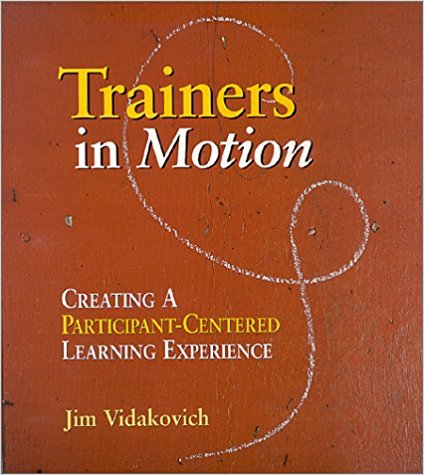Trainers in Motion Summary
5 min read ⌚
 Creating a Participant-Centered Learning Experience
Creating a Participant-Centered Learning Experience
Every business-environment has a set of standards and or ground rules to form a collective behavior.
Leaders, managers or any other decision-making body within the organization have to contribute to the building process of these standards.
Who Should Read “Trainer in Motion”? And Why?
The challenges occur as soon as managers, financiers, and step forward to analyze the current situation. Uncertainty is an integral part of any business, not to mention the risk presenting itself in any given opportunity.
We enter the race to co-join trainers and workshop leaders in the infrastructural analysis on how to create the best training program. This book is prescribed for all people working in different companies, eager to see the other side of practicing.
About Jim Vidakovich
 Jim Vidakovich is a trainer, trained expert in leadership, marketing consultant, motivational speaker and award-winning producer who currently lives in Los Angeles.
Jim Vidakovich is a trainer, trained expert in leadership, marketing consultant, motivational speaker and award-winning producer who currently lives in Los Angeles.
During his career, he has also worked at Children’s Television Workshop as a marketing director. Jim created several children’s educational programs and worked for dozens of others top-notch companies.
“Trainers in Motion Summary”
During the industrial period, imperialists wanted to program people’s minds to a point, where the workers would conduct the activities without questions. Manual workers raised their voice and showed their anger because they didn’t want to become robotized.
Instead, a fight for open-minded society emerged after years of silence. How would you deal with conflicts during project initiations? Sooner or later, companies realize that the best approach is allowing every organizational level to share its outlook on the situation.
Let them learn, think and participate in discussions because two heads are always better than one.
Traditionally, the people have always learned from the past. It is not natural to employ lectures from the future not even present. This training gap emerges and reflects the organizational inability to interact on all levels.
All things considered, the appearance of “management pitfalls” is inevitable. The most effective way of teaching is by stimulating open-discussions. Representative-centered learning is a technique used to provide a better learning process by valuing each other’s opinions.
Economical and fun approach forges future relationships which rely on mutual understanding. Training is more than an education process; it’s a series of tools, methods, and techniques which combine with a single purpose in mind – creating value.
Today’s digital age has plenty of new ways which bring out into open the necessity of participant’s involvement by using some props. Organizations are familiar with the majority of these training tools such as whistles, colored paper, cards, pipe cleaners and others.
The good thing about these materials is their wide use, most of them are particularly useful for presentations or any other visual point illustration. Small, medium and large companies are in а need of this equipment because not only that they are cheap but highly efficient as well.
One-on-one interactions can also be the cause for using them since there is no better way to draw a picture of company’s long-term plans than on a whiteboard. Lack of urgency can deprive the firm of commitment and deadline-chase. Nevertheless, “Trainers in Motion” is a book which solves all significant organization drawbacks, by revamping inefficient business processes.
Jim Vidakovic fiercely fights the immense societal pressures of today. The book is published in a binder with dividers, which gives you a lot of room, to share your opinion and leave comments. The readers are under the protection of Vidakovich’s approach that complies new methods that stimulate the involvement of participants.
Training has become something more natural, since the initial discussion has received a lot of praise. Vidakovich starts by focusing on the fundamental perspective filled with dozens of illustrations, takeaways, exercises, etc.
Collective leadership as a philosophy tends to solve self-centered problems but experience difficulties when creativity is a priority. Training programs step up to face these so-called organizational issues. Presentations require a set of tools in order to bring the point closer to the listener – which is not an easy task.
Depending on the company’s system you need to pick one of the three fundamental learning styles: visual perception, auditory and physical or make a combination of these three.
Key Lessons from “Trainers in Motion”
1. From start to finish adopt proper training techniques
2. Encourage freedom of speech
3. Merge all elements
From start to finish – adopt adequate training techniques
The first introduction rule is making a good first impression because unfortunately, you’ll never get a second chase. One of the most crucial elements of training success is how the people see you.
During the presentation, or meeting – walk around the office, let everyone feel your passion and commitment when displaying all the significant key points accurately.
Encourage freedom of speech
Training methods have greater chances of failure, if the leader is not 100% familiar with the corporate’s mission, vision, priorities, policies, and strategies.
Focus on creating and maintaining an atmosphere of support for the people working with you. Encourage the participants to share their thoughts on the subject without hesitation.
Merge all elements
Last but not least, as an expert in training programs, you must prioritize integration of all elements. There are three approaches from the participant side: Tell me, Show me, and Involve me.
Each one of them displays a different processing information method – useful for a particular situation. Select the best one.
Like this summary? We’d Like to invite you to download our free 12 min app, for more amazing summaries and audiobooks.
“Trainers in Motion” Quotes
The trainer is a facilitator of Knowledge, Skills, and Abilities. Share on X We process information from a linear or global perspective. Effective facilitation uses both of these methods in presenting content. Share on X First impressions are key to the success of your training event. Share on X A critical component of learning is doing. This same approach can be effectively applied to any learning environment, including the corporate training culture. Share on X To be more effective as a facilitator or trainer, there is a need to move away from the old school of thought. Share on XOur Critical Review
“Trainer in Motion” doesn’t adequately belong to any genre or category. Its mastery is widely spread throughout several classifications, covering key aspects of various niches. Although the Internet enables the companies to research on how to organize their Human Resources and process information the real trickery unfolds in face-to-face discussions.
The participants must be able to digest any information effortlessly, which can only occur if the point is illustrated in a timely fashion. Intended for all readers, this book provides hints and tips beneficial for every firm, despite the different shapes and sizes.
Emir is the Head of Marketing at 12min. In his spare time, he loves to meditate and play soccer.


 Creating a Participant-Centered Learning Experience
Creating a Participant-Centered Learning Experience




